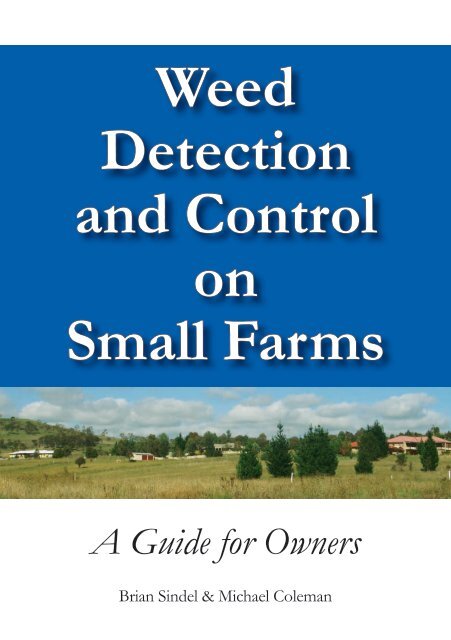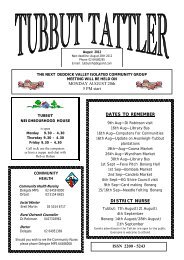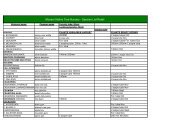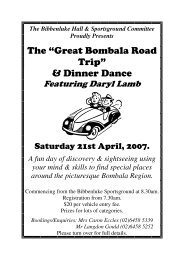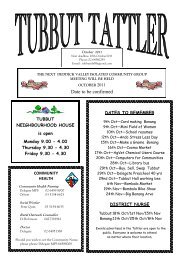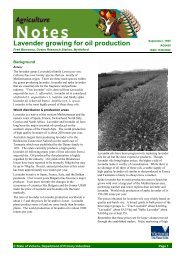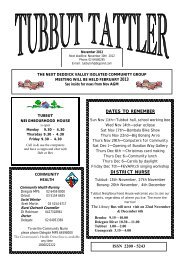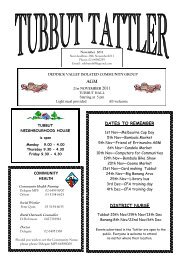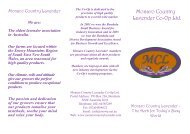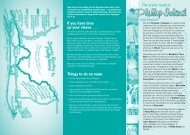Weed Detection and Control on Small Farms - University of New ...
Weed Detection and Control on Small Farms - University of New ...
Weed Detection and Control on Small Farms - University of New ...
You also want an ePaper? Increase the reach of your titles
YUMPU automatically turns print PDFs into web optimized ePapers that Google loves.
<str<strong>on</strong>g>Weed</str<strong>on</strong>g><br />
<str<strong>on</strong>g>Detecti<strong>on</strong></str<strong>on</strong>g><br />
<str<strong>on</strong>g>and</str<strong>on</strong>g> <str<strong>on</strong>g>C<strong>on</strong>trol</str<strong>on</strong>g><br />
<strong>on</strong><br />
<strong>Small</strong> <strong>Farms</strong><br />
A Guide for Owners<br />
Brian Sindel & Michael Coleman
Acknowledgements<br />
This booklet is a product <strong>of</strong> the <strong>University</strong> <strong>of</strong> <strong>New</strong> Engl<str<strong>on</strong>g>and</str<strong>on</strong>g> project Best practice for <strong>on</strong>-ground<br />
property weed detecti<strong>on</strong>, funded by the Defeating the <str<strong>on</strong>g>Weed</str<strong>on</strong>g> Menace R&D program.<br />
The Defeating the <str<strong>on</strong>g>Weed</str<strong>on</strong>g> Menace R&D was managed by L<str<strong>on</strong>g>and</str<strong>on</strong>g> & Water Australia <strong>on</strong> behalf<br />
<strong>of</strong> the Australian Government Department <strong>of</strong> Agriculture, Fisheries <str<strong>on</strong>g>and</str<strong>on</strong>g> Forestry <str<strong>on</strong>g>and</str<strong>on</strong>g> the<br />
Department <strong>of</strong> the Envir<strong>on</strong>ment, Water, Heritage <str<strong>on</strong>g>and</str<strong>on</strong>g> the Arts.<br />
We thank all the farmers <str<strong>on</strong>g>and</str<strong>on</strong>g> weeds <strong>of</strong>ficers who c<strong>on</strong>tributed ideas for this guide through<br />
our nati<strong>on</strong>al surveys. We are also grateful for the assistance <strong>of</strong> Jef Cummings (Biosecurity<br />
Queensl<str<strong>on</strong>g>and</str<strong>on</strong>g>), Catri<strong>on</strong>a King <str<strong>on</strong>g>and</str<strong>on</strong>g> Sim<strong>on</strong> B<strong>on</strong>wick (Victorian Department <strong>of</strong> Primary<br />
Industries), Stephen Johns<strong>on</strong>, Annette McCaffery <str<strong>on</strong>g>and</str<strong>on</strong>g> Birgitte Verbeek (Industry <str<strong>on</strong>g>and</str<strong>on</strong>g><br />
Investment <strong>New</strong> South Wales), Mark Trotter <str<strong>on</strong>g>and</str<strong>on</strong>g> Robin Jessop (<strong>University</strong> <strong>of</strong> <strong>New</strong> Engl<str<strong>on</strong>g>and</str<strong>on</strong>g>),<br />
John Virtue (Department <strong>of</strong> Water, L<str<strong>on</strong>g>and</str<strong>on</strong>g> <str<strong>on</strong>g>and</str<strong>on</strong>g> Biodiversity C<strong>on</strong>servati<strong>on</strong> South Australia),<br />
Rohan Rainbow <str<strong>on</strong>g>and</str<strong>on</strong>g> John S<str<strong>on</strong>g>and</str<strong>on</strong>g>ow (Grains Research <str<strong>on</strong>g>and</str<strong>on</strong>g> Development Corporati<strong>on</strong>),<br />
Rachel McFadyen (CRC for Australian <str<strong>on</strong>g>Weed</str<strong>on</strong>g> Management), Elisa Heylin (Australian Wool<br />
Innovati<strong>on</strong>), Peter Gregg (Cott<strong>on</strong> Catchment Communities CRC), Judy Lambert <str<strong>on</strong>g>and</str<strong>on</strong>g> Bruce<br />
Auld (L<str<strong>on</strong>g>and</str<strong>on</strong>g> & Water Australia), <str<strong>on</strong>g>and</str<strong>on</strong>g> James Browning (<strong>New</strong> Engl<str<strong>on</strong>g>and</str<strong>on</strong>g> <str<strong>on</strong>g>Weed</str<strong>on</strong>g>s Authority).<br />
With the excepti<strong>on</strong> <strong>of</strong> the photograph <strong>on</strong> page 18 (‘blackberry rust’, <str<strong>on</strong>g>Weed</str<strong>on</strong>g>s CRC/CSIRO<br />
Entomology), all photographs used in this booklet are sourced from Brian Sindel <str<strong>on</strong>g>and</str<strong>on</strong>g> the<br />
Institute for Rural Futures, <strong>University</strong> <strong>of</strong> <strong>New</strong> Engl<str<strong>on</strong>g>and</str<strong>on</strong>g>.<br />
Publicati<strong>on</strong> Details<br />
© <strong>University</strong> <strong>of</strong> <strong>New</strong> Engl<str<strong>on</strong>g>and</str<strong>on</strong>g> 2010 All rights reserved.<br />
ISBN 978-1-921597-07-7<br />
Brian Sindel, School <strong>of</strong> Envir<strong>on</strong>mental <str<strong>on</strong>g>and</str<strong>on</strong>g> Rural Science, <str<strong>on</strong>g>and</str<strong>on</strong>g> Michael Coleman, Institute for<br />
Rural Futures, <strong>University</strong> <strong>of</strong> <strong>New</strong> Engl<str<strong>on</strong>g>and</str<strong>on</strong>g>.<br />
C<strong>on</strong>tact<br />
Pr<strong>of</strong>essor Brian Sindel, Agr<strong>on</strong>omy <str<strong>on</strong>g>and</str<strong>on</strong>g> Soil Science, School <strong>of</strong> Envir<strong>on</strong>mental <str<strong>on</strong>g>and</str<strong>on</strong>g> Rural<br />
Science, <strong>University</strong> <strong>of</strong> <strong>New</strong> Engl<str<strong>on</strong>g>and</str<strong>on</strong>g>, Armidale, NSW, Australia 2351; 02 6773 3747;<br />
bsindel@une.edu.au<br />
Disclaimers<br />
Descripti<strong>on</strong>s <strong>of</strong> herbicide use in this guide are not to be taken as recommendati<strong>on</strong>s. Herbicides<br />
must <strong>on</strong>ly be used in accordance with the recommendati<strong>on</strong>s provided <strong>on</strong> herbicide labels.<br />
L<str<strong>on</strong>g>and</str<strong>on</strong>g>holders are advised to c<strong>on</strong>sult with their State or Territory government departments<br />
regarding the legal requirements relating to weed c<strong>on</strong>trol.
C<strong>on</strong>tents<br />
Introducti<strong>on</strong>................................................................................................ 2<br />
What is a weed?......................................................................................... 4<br />
How do weeds spread?............................................................................ 5<br />
Minimising weed spread <strong>on</strong> your property......................................... 6<br />
Why is it important to c<strong>on</strong>trol weeds <strong>on</strong> small farms?................... 7<br />
What are the principles <strong>of</strong> weed detecti<strong>on</strong>?...................................... 8<br />
Where should I look for weeds <strong>on</strong> my farm?...................................................................8<br />
When should I look for weeds?.................................................................................................9<br />
How do I identify an unknown weed or unusual plant?.........................................11<br />
How do I collect <str<strong>on</strong>g>and</str<strong>on</strong>g> preserve a weed specimen for identificati<strong>on</strong>?.............12<br />
What should I do when I find a new weed outbreak? ...........................................13<br />
<str<strong>on</strong>g>C<strong>on</strong>trol</str<strong>on</strong>g>ling weed outbreaks <strong>on</strong> your farm.......................................14<br />
What are my weed c<strong>on</strong>trol resp<strong>on</strong>sibilities?..................................................................14<br />
Which c<strong>on</strong>trol methods are suitable for small farm owners?.............................14<br />
A word <strong>on</strong> biological c<strong>on</strong>trol.....................................................................................................18<br />
How do I c<strong>on</strong>trol large-scale weed outbreaks?............................................................19<br />
What are the guidelines for resp<strong>on</strong>sible use <strong>of</strong> herbicides?.................................20<br />
Chemical certificati<strong>on</strong> or accreditati<strong>on</strong>.............................................21<br />
What assistance is available to c<strong>on</strong>trol weeds <strong>on</strong> my l<str<strong>on</strong>g>and</str<strong>on</strong>g>?.........22<br />
Pers<strong>on</strong>al assistance........................................................................................................................22<br />
Financial assistance........................................................................................................................23<br />
Where can I get further informati<strong>on</strong>?................................................24<br />
References <str<strong>on</strong>g>and</str<strong>on</strong>g> further reading...........................................................25<br />
<str<strong>on</strong>g>Weed</str<strong>on</strong>g> identificati<strong>on</strong> resources.............................................................26<br />
<str<strong>on</strong>g>Weed</str<strong>on</strong>g> outbreak record..........................................................................28
Introducti<strong>on</strong><br />
<str<strong>on</strong>g>Weed</str<strong>on</strong>g>s c<strong>on</strong>stitute a significant cost to Australian agriculture each year,<br />
both in terms <strong>of</strong> c<strong>on</strong>trol <str<strong>on</strong>g>and</str<strong>on</strong>g> lost productivity. However, weeds also cause<br />
problems for the owners <strong>of</strong> small ‘hobby’ or lifestyle farms.<br />
Apart from the legal obligati<strong>on</strong> to c<strong>on</strong>trol certain weeds, extensive weed<br />
outbreaks <strong>on</strong> small farms may:<br />
• impact <strong>on</strong> biodiversity <str<strong>on</strong>g>and</str<strong>on</strong>g> human health;<br />
• spread to neighbouring l<str<strong>on</strong>g>and</str<strong>on</strong>g>, including producti<strong>on</strong> farms, which in turn<br />
may strain community relati<strong>on</strong>ships;<br />
• cut significantly into niche-farming pr<strong>of</strong>its;<br />
• detract from time better spent <strong>on</strong> other activities;<br />
• make it more difficult to restore natural habitats <strong>on</strong> your l<str<strong>on</strong>g>and</str<strong>on</strong>g>;<br />
• detract from the natural beauty <strong>of</strong> your l<str<strong>on</strong>g>and</str<strong>on</strong>g> <str<strong>on</strong>g>and</str<strong>on</strong>g> reduce its value;<br />
• increase farm costs;<br />
• be toxic or harmful to livestock <str<strong>on</strong>g>and</str<strong>on</strong>g> pets;<br />
• harbour feral animals such as rabbits <str<strong>on</strong>g>and</str<strong>on</strong>g> foxes; <str<strong>on</strong>g>and</str<strong>on</strong>g><br />
• make it difficult to access certain areas <strong>of</strong> your farm.<br />
The primary emphasis <strong>of</strong> this booklet is <strong>on</strong> the importance <strong>of</strong> detecting <str<strong>on</strong>g>and</str<strong>on</strong>g><br />
c<strong>on</strong>trolling weeds <strong>on</strong> your l<str<strong>on</strong>g>and</str<strong>on</strong>g> before they have a chance to spread. It is also important<br />
to seek advice <str<strong>on</strong>g>and</str<strong>on</strong>g> assistance from your local weeds <strong>of</strong>ficer, <str<strong>on</strong>g>and</str<strong>on</strong>g>, when necessary, to<br />
work with your neighbours to c<strong>on</strong>trol weeds. In the l<strong>on</strong>ger term, effective <str<strong>on</strong>g>and</str<strong>on</strong>g><br />
diligent weed c<strong>on</strong>trol will make managing your farm easier <str<strong>on</strong>g>and</str<strong>on</strong>g> less timec<strong>on</strong>suming,<br />
<str<strong>on</strong>g>and</str<strong>on</strong>g> will allow you to focus <strong>on</strong> the enjoyable aspects <strong>of</strong> living<br />
in rural Australia.<br />
In the following pages we discuss the significance <strong>of</strong> weeds to small farms<br />
in Australia, <str<strong>on</strong>g>and</str<strong>on</strong>g> summarise best practice weed detecti<strong>on</strong> <str<strong>on</strong>g>and</str<strong>on</strong>g> c<strong>on</strong>trol<br />
methods most appropriate to small farm owners. Much <strong>of</strong> this informati<strong>on</strong><br />
is based <strong>on</strong> a 2008 nati<strong>on</strong>al survey <strong>of</strong> weed <strong>of</strong>ficers <str<strong>on</strong>g>and</str<strong>on</strong>g> l<str<strong>on</strong>g>and</str<strong>on</strong>g>holders.<br />
2
It is important to underst<str<strong>on</strong>g>and</str<strong>on</strong>g> the ‘principles’ <strong>of</strong> weed detecti<strong>on</strong> <str<strong>on</strong>g>and</str<strong>on</strong>g> c<strong>on</strong>trol:<br />
what c<strong>on</strong>stitutes a weed, how weeds spread, where <str<strong>on</strong>g>and</str<strong>on</strong>g> when to look for<br />
weeds <strong>on</strong> your l<str<strong>on</strong>g>and</str<strong>on</strong>g>, how to detect weeds <str<strong>on</strong>g>and</str<strong>on</strong>g> identify unknown species,<br />
<str<strong>on</strong>g>and</str<strong>on</strong>g> the best methods to c<strong>on</strong>trol weed outbreaks quickly.<br />
C<strong>on</strong>siderable informati<strong>on</strong>, assistance <str<strong>on</strong>g>and</str<strong>on</strong>g> resources are available to help<br />
l<str<strong>on</strong>g>and</str<strong>on</strong>g>holders c<strong>on</strong>trol weeds <strong>on</strong> their properties. For small farm owners,<br />
however, external assistance can be expensive, difficult to access, or more<br />
appropriate to large-scale producti<strong>on</strong> agriculture.<br />
Therefore, towards the end <strong>of</strong> this booklet, opti<strong>on</strong>s for small farm owners<br />
seeking assistance with weed c<strong>on</strong>trol are discussed. You will also find a<br />
list <strong>of</strong> c<strong>on</strong>tact details for relevant authorities in your State or Territory,<br />
<str<strong>on</strong>g>and</str<strong>on</strong>g> a list <strong>of</strong> useful references (weed identificati<strong>on</strong> booklets, brochures <str<strong>on</strong>g>and</str<strong>on</strong>g><br />
websites).<br />
3
What is a weed?<br />
<str<strong>on</strong>g>Weed</str<strong>on</strong>g>s are plants that require some form<br />
<strong>of</strong> acti<strong>on</strong> to reduce their harmful effects <strong>on</strong><br />
farmers’ livelihoods, the ec<strong>on</strong>omy, envir<strong>on</strong>ment,<br />
human health <str<strong>on</strong>g>and</str<strong>on</strong>g> amenity.<br />
Around 28,000 plant species have been introduced into Australia since<br />
European settlement. More than 2,770 <strong>of</strong> these have become naturalised<br />
<str<strong>on</strong>g>and</str<strong>on</strong>g> weedy, <strong>of</strong> which around 65% are c<strong>on</strong>sidered a problem for natural<br />
ecosystems <str<strong>on</strong>g>and</str<strong>on</strong>g> about 35% are c<strong>on</strong>sidered a problem for agricultural<br />
systems.<br />
In additi<strong>on</strong> to plants not native to Australia, weeds may include native<br />
plants that are growing outside their known natural range.<br />
Some weeds are declared under legislati<strong>on</strong> as requiring c<strong>on</strong>trol by all<br />
l<str<strong>on</strong>g>and</str<strong>on</strong>g>holders. These are usually particularly harmful <str<strong>on</strong>g>and</str<strong>on</strong>g> may not yet have<br />
spread far, <str<strong>on</strong>g>and</str<strong>on</strong>g> so it is in the wider community’s best interest if individual<br />
l<str<strong>on</strong>g>and</str<strong>on</strong>g>holders are required by law to c<strong>on</strong>trol these weeds <strong>on</strong> their l<str<strong>on</strong>g>and</str<strong>on</strong>g>.<br />
Other more widespread weeds may not be declared under legislati<strong>on</strong>,<br />
but there is an ec<strong>on</strong>omic <str<strong>on</strong>g>and</str<strong>on</strong>g> envir<strong>on</strong>mental imperative for individual<br />
l<str<strong>on</strong>g>and</str<strong>on</strong>g>holders to manage such weeds.<br />
Each weed species may pose a threat to different regi<strong>on</strong>s or parts <strong>of</strong><br />
Australia, depending <strong>on</strong> factors such as climate <str<strong>on</strong>g>and</str<strong>on</strong>g> the extent to which<br />
the weed has taken hold in a regi<strong>on</strong>. Some species may be declared or<br />
prohibited at a State/Territory or Federal level, while others may <strong>on</strong>ly be<br />
prohibited at a regi<strong>on</strong>al level (for example, a catchment or local government<br />
area).<br />
To obtain a list <strong>of</strong> declared species for your regi<strong>on</strong>, c<strong>on</strong>tact your local<br />
weeds <strong>of</strong>ficer, weeds authority, council/local government <strong>of</strong>fice, or your<br />
State or Territory department <strong>of</strong> agriculture or primary industries. A list<br />
<strong>of</strong> weed identificati<strong>on</strong> resources is also included <strong>on</strong> pages 26 <str<strong>on</strong>g>and</str<strong>on</strong>g> 27.<br />
4
How do weeds spread?<br />
There are many different causes <strong>of</strong> weed spread. In reality, anything that<br />
moves or is moved may cause weeds to spread. Seventeen ‘pathways’ <strong>of</strong><br />
weed spread have been identified in Australia (Sindel et al. 2008b).<br />
• Deliberate spread by humans: aquarium plant trade, fodder trade, food plant<br />
trade, medicinal plant trade, ornamental plant trade, revegetati<strong>on</strong> <str<strong>on</strong>g>and</str<strong>on</strong>g><br />
forestry.<br />
• Accidental spread by humans: agricultural produce, c<strong>on</strong>structi<strong>on</strong> <str<strong>on</strong>g>and</str<strong>on</strong>g><br />
l<str<strong>on</strong>g>and</str<strong>on</strong>g>scaping materials, human apparel <str<strong>on</strong>g>and</str<strong>on</strong>g> equipment, livestock<br />
movement, machinery <str<strong>on</strong>g>and</str<strong>on</strong>g> vehicles, research sites, waste disposal.<br />
• Natural spread: birds, other animals, water, wind.<br />
The pathways most likely to spread weeds <strong>on</strong> farms include birds, wind,<br />
water, machinery <str<strong>on</strong>g>and</str<strong>on</strong>g> vehicles, hay <str<strong>on</strong>g>and</str<strong>on</strong>g> fodder, <str<strong>on</strong>g>and</str<strong>on</strong>g> livestock.<br />
On small farm blocks, other pathways including ornamental plant trade<br />
(gardens <str<strong>on</strong>g>and</str<strong>on</strong>g> exotic tree plantings), food plant trade (orchards <str<strong>on</strong>g>and</str<strong>on</strong>g><br />
vegetable gardens) <str<strong>on</strong>g>and</str<strong>on</strong>g> l<str<strong>on</strong>g>and</str<strong>on</strong>g>scaping materials (mulches, gravel <str<strong>on</strong>g>and</str<strong>on</strong>g><br />
topsoils) will also be important.<br />
5
Minimising weed spread <strong>on</strong> your<br />
property<br />
By identifying the potential ways in which weeds may spread <strong>on</strong>to your<br />
property, you may be able to implement some simple measures to reduce<br />
the appearance <strong>of</strong> new weeds in your paddocks or garden, or minimise the<br />
spread <strong>of</strong> weeds from <strong>on</strong>e area <strong>of</strong> your property to another.<br />
The best way to minimise weed spread <strong>on</strong>to<br />
other parts <strong>of</strong> your property, or <strong>on</strong>to neighbouring<br />
properties, is to eradicate the weeds at the source<br />
as so<strong>on</strong> as possible. In the l<strong>on</strong>ger term, you will<br />
have less weeds to remove, <str<strong>on</strong>g>and</str<strong>on</strong>g> will generally have<br />
to remove them from fewer locati<strong>on</strong>s.<br />
Some reducti<strong>on</strong> in the spread <strong>of</strong> weeds <strong>on</strong> your farm can be achieved<br />
by restricting the movement <strong>of</strong> newly acquired livestock, in case they are<br />
carrying weed seeds (inside or outside). It is also worth restricting the areas<br />
where <strong>of</strong>f-farm fodder is fed to livestock, in case it is c<strong>on</strong>taminated.<br />
Other measures to prevent weeds spreading <strong>on</strong>to your l<str<strong>on</strong>g>and</str<strong>on</strong>g> may include<br />
ensuring that potential weed species are not planted in the garden, removing<br />
garden plants that appear to be spreading into the paddocks, purchasing<br />
stock fodder that has been certified weed-free, ensuring your vehicles, or<br />
c<strong>on</strong>tractor vehicles, do not carry weed seeds <strong>on</strong>to your property from<br />
another recently visited property, or ensuring that seed attached to your<br />
clothing is removed <str<strong>on</strong>g>and</str<strong>on</strong>g> destroyed.<br />
When you have determined which weed species are prevalent <strong>on</strong> your l<str<strong>on</strong>g>and</str<strong>on</strong>g><br />
or in your district, it is worth seeking advice from your local weeds <strong>of</strong>ficer<br />
to determine what can be d<strong>on</strong>e to limit the spread <strong>of</strong> these particular<br />
species.<br />
6
Why is it important to c<strong>on</strong>trol<br />
weeds <strong>on</strong> small farms?<br />
Given the estimated cost <strong>of</strong> weeds to Australian agriculture <strong>of</strong> $4 billi<strong>on</strong><br />
annually (Sinden et al. 2004), the focus <strong>of</strong> weeds pr<strong>of</strong>essi<strong>on</strong>als <str<strong>on</strong>g>and</str<strong>on</strong>g> agencies<br />
is largely <strong>on</strong> the ec<strong>on</strong>omic benefits <strong>of</strong> c<strong>on</strong>trolling weeds to maximise farm<br />
pr<strong>of</strong>its, <strong>on</strong> the legal requirements <strong>of</strong> c<strong>on</strong>trolling prohibited or declared<br />
species, or <strong>on</strong> biosecurity.<br />
However, most small farm owners have purchased l<str<strong>on</strong>g>and</str<strong>on</strong>g> not to make a<br />
pr<strong>of</strong>it, but to realise a variety <strong>of</strong> n<strong>on</strong>-ec<strong>on</strong>omic ‘lifestyle’ goals, including<br />
habitat restorati<strong>on</strong>, self-sufficiency, family well-being, involvement in a rural<br />
community, <str<strong>on</strong>g>and</str<strong>on</strong>g>/or small-scale hobby farming (Hollier <str<strong>on</strong>g>and</str<strong>on</strong>g> Reid 2007).<br />
Many small farm managers in Australia are keen to do more to c<strong>on</strong>trol<br />
weeds <strong>on</strong> their l<str<strong>on</strong>g>and</str<strong>on</strong>g>. Where small farm managers are unable to c<strong>on</strong>trol<br />
weeds effectively, it is mostly due to lack <strong>of</strong> time, knowledge, or equipment,<br />
rather than lack <strong>of</strong> motivati<strong>on</strong> (Low Choy <str<strong>on</strong>g>and</str<strong>on</strong>g> Harding 2008).<br />
Early weed detecti<strong>on</strong> <str<strong>on</strong>g>and</str<strong>on</strong>g> <strong>on</strong>-going c<strong>on</strong>trol is vital to effective l<str<strong>on</strong>g>and</str<strong>on</strong>g><br />
management <strong>on</strong> a small farm, <str<strong>on</strong>g>and</str<strong>on</strong>g> may prevent costly ec<strong>on</strong>omic,<br />
envir<strong>on</strong>mental <str<strong>on</strong>g>and</str<strong>on</strong>g> human health <str<strong>on</strong>g>and</str<strong>on</strong>g> amenity impacts in the future. It is<br />
essential to find <str<strong>on</strong>g>and</str<strong>on</strong>g> eradicate new weeds before they become troublesome.<br />
Early detecti<strong>on</strong> <str<strong>on</strong>g>and</str<strong>on</strong>g> preventi<strong>on</strong> is better than cure!<br />
Keeping the weeds <strong>on</strong> your l<str<strong>on</strong>g>and</str<strong>on</strong>g> under c<strong>on</strong>trol will help you to enjoy your<br />
farm <str<strong>on</strong>g>and</str<strong>on</strong>g> get the most out <strong>of</strong> it. An extensive weed outbreak <strong>on</strong> your<br />
property will be expensive <str<strong>on</strong>g>and</str<strong>on</strong>g> time-c<strong>on</strong>suming to c<strong>on</strong>trol, may strain<br />
relati<strong>on</strong>ships with your neighbours, <str<strong>on</strong>g>and</str<strong>on</strong>g> will make it difficult to achieve<br />
other goals such as hobby farming or habitat restorati<strong>on</strong>.<br />
Being diligent in detecting <str<strong>on</strong>g>and</str<strong>on</strong>g> c<strong>on</strong>trolling weeds will minimise<br />
the chance <strong>of</strong> a large outbreak, will save you time <str<strong>on</strong>g>and</str<strong>on</strong>g> m<strong>on</strong>ey,<br />
<str<strong>on</strong>g>and</str<strong>on</strong>g> will help you to enjoy the benefits <strong>of</strong> a rural lifestyle.<br />
The first step in c<strong>on</strong>trolling weeds is successful detecti<strong>on</strong>. In the next few<br />
pages we summarise ‘best practice’ principles for detecting weeds <strong>on</strong> your<br />
farm.<br />
7
What are the principles <strong>of</strong> weed<br />
detecti<strong>on</strong>?<br />
Where should I look for weeds <strong>on</strong> my farm?<br />
• Near <str<strong>on</strong>g>and</str<strong>on</strong>g> downwind <strong>of</strong> previous weed infestati<strong>on</strong> areas<br />
• Watercourses <str<strong>on</strong>g>and</str<strong>on</strong>g> dams, particularly after floods<br />
• Roadways <str<strong>on</strong>g>and</str<strong>on</strong>g> traffic areas<br />
• Areas in which earthmoving <str<strong>on</strong>g>and</str<strong>on</strong>g> other c<strong>on</strong>tractors have been working<br />
• Boundaries with neighbours <str<strong>on</strong>g>and</str<strong>on</strong>g> al<strong>on</strong>g fencelines<br />
• Livestock camps <str<strong>on</strong>g>and</str<strong>on</strong>g> feeding areas<br />
• <strong>New</strong>ly sown crop <str<strong>on</strong>g>and</str<strong>on</strong>g> pasture paddocks<br />
• In remote or relatively inaccessible areas (such as remnant bushl<str<strong>on</strong>g>and</str<strong>on</strong>g>)<br />
• Near sheds, tanks, stock yards <str<strong>on</strong>g>and</str<strong>on</strong>g> other structures<br />
• Revegetati<strong>on</strong> areas (e.g. tree plantings) <str<strong>on</strong>g>and</str<strong>on</strong>g> gardens (particularly new<br />
gardens where mulch or topsoil has been used)<br />
When determining where <strong>on</strong> your property to check for weeds, c<strong>on</strong>sider:<br />
• those areas that have had weed infestati<strong>on</strong>s in previous seas<strong>on</strong>s (seeds can<br />
<strong>of</strong>ten persist in the soil for many years); <str<strong>on</strong>g>and</str<strong>on</strong>g><br />
• focusing <strong>on</strong> areas <strong>on</strong> your property that may be particularly vulnerable<br />
to new weed infestati<strong>on</strong>s, such as those listed above (identify these areas <str<strong>on</strong>g>and</str<strong>on</strong>g><br />
inspect them for weeds <strong>on</strong> a regular basis).<br />
Relatively inaccessible areas <strong>on</strong> your property (such as areas <strong>of</strong> dense<br />
vegetati<strong>on</strong>, remote areas, steep <str<strong>on</strong>g>and</str<strong>on</strong>g>/or rocky country) may be difficult to<br />
check for weeds. However, it is these areas which <strong>of</strong>ten have new weed<br />
infestati<strong>on</strong>s, for example, those spread by birds. On a small farm, it may<br />
be more practical to inspect difficult areas <strong>on</strong> foot, horseback, motorbike<br />
or quad bike, <str<strong>on</strong>g>and</str<strong>on</strong>g> to inspect other areas using a vehicle.<br />
If you are new to your property, or are not certain which areas may be most<br />
vulnerable to weeds, you should ask your local weeds <strong>of</strong>ficer, agr<strong>on</strong>omist,<br />
or your neighbours for advice. The parts <strong>of</strong> a property where weeds are<br />
most likely to be found vary across Australia.<br />
8
When should I look for weeds?<br />
<str<strong>on</strong>g>Weed</str<strong>on</strong>g> detecti<strong>on</strong> becomes a more important issue at certain times <strong>of</strong> year.<br />
The best time or times <strong>of</strong> year to look for weeds <strong>on</strong> your property will<br />
depend <strong>on</strong> the climate, the species <strong>of</strong> weeds prevalent in the district, <str<strong>on</strong>g>and</str<strong>on</strong>g><br />
the type <strong>of</strong> farm you own.<br />
For example, farmers in southern regi<strong>on</strong>s with a typical Mediterranean-type<br />
climate will check for weeds after the start <strong>of</strong> the autumn ‘break’ (first rains<br />
after a typical dry summer), or in early spring when there is still sufficient<br />
soil moisture from winter rains <str<strong>on</strong>g>and</str<strong>on</strong>g> warmer temperatures for weed growth.<br />
In northern m<strong>on</strong>so<strong>on</strong>al Australia, weeds will be best detected over the wet<br />
summer. However, in other parts <strong>of</strong> Australia, such as the subtropics <str<strong>on</strong>g>and</str<strong>on</strong>g><br />
arid inl<str<strong>on</strong>g>and</str<strong>on</strong>g>, time <strong>of</strong> year may be less important, due to relatively warmer<br />
temperatures, rainfall occurring at any time throughout the year, or the<br />
relative importance <strong>of</strong> year-round species.<br />
The best approach is to check your property for weeds<br />
while doing other jobs, but also to undertake regular<br />
specific paddock inspecti<strong>on</strong>s.<br />
9
Why is time <strong>of</strong> year important for weed detecti<strong>on</strong>?<br />
• Each weed species has a particular life-cycle, <str<strong>on</strong>g>and</str<strong>on</strong>g> time <strong>of</strong> year when it is<br />
flowering or producing seed. It is important to detect <str<strong>on</strong>g>and</str<strong>on</strong>g> c<strong>on</strong>trol weeds<br />
early in their life-cycle before they produce seed (there is a well known<br />
saying that “<strong>on</strong>e year’s seeding is 7 years weeding!”).<br />
• Some weed species are more noticeable at certain times <strong>of</strong> year.<br />
• Often you will have the best chance <strong>of</strong> killing or c<strong>on</strong>trolling weeds, at least<br />
with herbicides, when they are young <str<strong>on</strong>g>and</str<strong>on</strong>g> actively growing.<br />
• Seas<strong>on</strong>al <str<strong>on</strong>g>and</str<strong>on</strong>g> climatic c<strong>on</strong>diti<strong>on</strong>s, particularly rainfall, influence the time <strong>of</strong><br />
year when weeds are most likely to grow quickly.<br />
• Likewise, major disturbances that create bare ground, such as floods, fire,<br />
cycl<strong>on</strong>es, drought <str<strong>on</strong>g>and</str<strong>on</strong>g> overgrazing, <str<strong>on</strong>g>and</str<strong>on</strong>g> even weed c<strong>on</strong>trol activity (such as<br />
spraying <strong>of</strong> herbicide) can c<strong>on</strong>tribute to weed infestati<strong>on</strong>.<br />
It is important to know which weed species are most likely to grow<br />
<strong>on</strong> your l<str<strong>on</strong>g>and</str<strong>on</strong>g>, <str<strong>on</strong>g>and</str<strong>on</strong>g> to be aware <strong>of</strong> how the factors above will affect<br />
the growth <strong>of</strong> these species. A list <strong>of</strong> weed identificati<strong>on</strong> resources<br />
is provided at the end <strong>of</strong> this booklet. Your State department <strong>of</strong><br />
agriculture or primary industries, or weeds <strong>of</strong>ficer may also be able<br />
to provide fact sheets or further informati<strong>on</strong> <strong>on</strong> when specific weed<br />
species are likely to grow.<br />
10
How do I identify an unknown weed or unusual<br />
plant?<br />
L<str<strong>on</strong>g>and</str<strong>on</strong>g>holders may undertake a variety <strong>of</strong> identificati<strong>on</strong> measures when they<br />
find an unknown or unusual plant <strong>on</strong> their property, including:<br />
• asking a local pr<strong>of</strong>essi<strong>on</strong>al such as a weeds <strong>of</strong>ficer or agr<strong>on</strong>omist for<br />
advice (see the secti<strong>on</strong> Where can I get further informati<strong>on</strong>?) – best opti<strong>on</strong>;<br />
• using a weed identificati<strong>on</strong> book, a web site, or other reference materials<br />
(a list <strong>of</strong> useful materials is provided at the end <strong>of</strong> this booklet) – a good<br />
starting point then c<strong>on</strong>firm by using pr<strong>of</strong>essi<strong>on</strong>al identificati<strong>on</strong> service<br />
or weeds expert; <str<strong>on</strong>g>and</str<strong>on</strong>g><br />
• asking a neighbour (particularly <strong>on</strong>e who is an experienced farm manager),<br />
other l<str<strong>on</strong>g>and</str<strong>on</strong>g>holder or L<str<strong>on</strong>g>and</str<strong>on</strong>g>care member for advice – a good starting point<br />
then follow if unsure with weed pr<strong>of</strong>essi<strong>on</strong>al or identificati<strong>on</strong> service.<br />
Noting the c<strong>on</strong>diti<strong>on</strong>s in which the plant was growing, e.g. a wet area in<br />
a grazed paddock, can sometimes assist these people in identifying the<br />
plant.<br />
It is important to identify an unknown or previously unseen plant <strong>on</strong> your<br />
l<str<strong>on</strong>g>and</str<strong>on</strong>g> as so<strong>on</strong> as possible, to determine whether it is a weed <str<strong>on</strong>g>and</str<strong>on</strong>g> how to<br />
c<strong>on</strong>trol it. If the plant is a weed, early identificati<strong>on</strong> <str<strong>on</strong>g>and</str<strong>on</strong>g> removal will<br />
give you the best chance <strong>of</strong> c<strong>on</strong>trolling the weed before it has a chance to<br />
spread <str<strong>on</strong>g>and</str<strong>on</strong>g> become a larger problem next seas<strong>on</strong>.<br />
Why should I seek advice <strong>on</strong> unknown plants?<br />
In the event that you find an unknown plant, it is highly recommended<br />
that you c<strong>on</strong>tact your local weeds <strong>of</strong>ficer or local government <strong>of</strong>fice<br />
for immediate advice. <str<strong>on</strong>g>Weed</str<strong>on</strong>g>s <strong>of</strong>ficers receive training in weed<br />
identificati<strong>on</strong>, <str<strong>on</strong>g>and</str<strong>on</strong>g> have access to other weed identificati<strong>on</strong> services<br />
including government agencies, agr<strong>on</strong>omists, botanists, <str<strong>on</strong>g>and</str<strong>on</strong>g> herbaria.<br />
They can also provide you with informati<strong>on</strong> <strong>on</strong> the high priority<br />
weeds for which you should be looking.<br />
A list <strong>of</strong> c<strong>on</strong>tacts is provided in the secti<strong>on</strong> Where can I get further<br />
informati<strong>on</strong>?<br />
11
How do I collect <str<strong>on</strong>g>and</str<strong>on</strong>g> preserve a weed specimen<br />
for identificati<strong>on</strong>?<br />
For proper identificati<strong>on</strong>, a flower or other reproductive part <strong>of</strong> the plant,<br />
for example, a fruit that c<strong>on</strong>tains the seed, is almost always required. You<br />
should therefore aim to collect <strong>on</strong>e or two plants that have these ‘structures’<br />
<strong>on</strong> them to take to your local weeds pr<strong>of</strong>essi<strong>on</strong>al for identificati<strong>on</strong>. For<br />
large weeds, <strong>on</strong>ly part <strong>of</strong> the plant needs to be collected, as l<strong>on</strong>g as it<br />
c<strong>on</strong>tains all the types <strong>of</strong> structures <strong>of</strong> the plant, for example, leaves, stems,<br />
flowers <str<strong>on</strong>g>and</str<strong>on</strong>g> fruit. Storing the plant in a sealed plastic bag in a cool place<br />
out <strong>of</strong> the sun or in the fridge will keep it fresh for a day or two for ease <strong>of</strong><br />
identificati<strong>on</strong>, <str<strong>on</strong>g>and</str<strong>on</strong>g> also eliminate the chance <strong>of</strong> seed spread.<br />
Where the time between collecti<strong>on</strong> <str<strong>on</strong>g>and</str<strong>on</strong>g> identificati<strong>on</strong> is likely to be l<strong>on</strong>ger<br />
than a day, plants may need to be preserved in their original state by<br />
immediately pressing <str<strong>on</strong>g>and</str<strong>on</strong>g> drying them between sheets <strong>of</strong> newspaper (4<br />
or 5 at least <strong>on</strong> each side), with a heavy object <strong>on</strong> top. It is important to<br />
change the newspaper every couple <strong>of</strong> days until the specimen is dried.<br />
The flattened <str<strong>on</strong>g>and</str<strong>on</strong>g> dried specimen can then be taken for identificati<strong>on</strong> as is,<br />
or taped to a piece <strong>of</strong> stiff paper or cardboard for easier display.<br />
Digital photographs can also be taken <strong>of</strong> your unknown plant <str<strong>on</strong>g>and</str<strong>on</strong>g> shown<br />
or emailed to your weeds <strong>of</strong>ficer for identificati<strong>on</strong>. However, these need<br />
to include close-ups <strong>of</strong> all the parts as well as images <strong>of</strong> the whole plant.<br />
Photographs may also be preferable over a plant specimen when there is<br />
<strong>on</strong>ly <strong>on</strong>e plant in the field (it could be a rare native species that requires<br />
protecti<strong>on</strong>) or when the weeds are seeding <str<strong>on</strong>g>and</str<strong>on</strong>g> there is a chance <strong>of</strong> weed<br />
spread if the plant is moved.<br />
12
What should I do when I find a new weed<br />
outbreak?<br />
When farmers detect new weeds <strong>on</strong> their property, they are <strong>of</strong>ten marked<br />
(for example, with a stick, pole, or pile <strong>of</strong> rocks), or recorded in a farm<br />
note book or paddock diary if the farmer has <strong>on</strong>e.<br />
Once you have identified the plant, <str<strong>on</strong>g>and</str<strong>on</strong>g> if it is c<strong>on</strong>sidered to be a serious<br />
weed, then it is important to notify your local weeds <strong>of</strong>ficer <strong>of</strong> the outbreak.<br />
They will record the locati<strong>on</strong> <strong>of</strong> the outbreak, <str<strong>on</strong>g>and</str<strong>on</strong>g> seek to manage the<br />
spread <strong>of</strong> the weed at the regi<strong>on</strong>al level.<br />
The aim in marking <str<strong>on</strong>g>and</str<strong>on</strong>g> recording a weed ‘find’ is to be able to come back<br />
<str<strong>on</strong>g>and</str<strong>on</strong>g> regularly check the locati<strong>on</strong>. It is likely that if <strong>on</strong>e weed is found, more<br />
plants will be found at that site in the future, particularly if that plant or<br />
another has set seed. The weeds seen above ground may <strong>on</strong>ly be 5% <strong>of</strong><br />
what is there in total. Up to 95% may be seeds <strong>on</strong> <str<strong>on</strong>g>and</str<strong>on</strong>g> in the ground.<br />
The time over which weed seeds will persist in the soil varies greatly between<br />
species, <str<strong>on</strong>g>and</str<strong>on</strong>g> so <strong>on</strong>ce a new weed is found, the locati<strong>on</strong> needs to be marked<br />
or recorded in some way <str<strong>on</strong>g>and</str<strong>on</strong>g> then checked regularly for a period <strong>of</strong> up to<br />
5 years for new outbreaks, assuming no more seeds arrive at that site.<br />
The most important acti<strong>on</strong> to take when finding a new weed outbreak<br />
<strong>on</strong> your property is to c<strong>on</strong>trol the weeds as so<strong>on</strong> as possible. In the next<br />
secti<strong>on</strong> <strong>of</strong> this booklet we discuss appropriate weed c<strong>on</strong>trol methods for<br />
small farm owners.<br />
13
<str<strong>on</strong>g>C<strong>on</strong>trol</str<strong>on</strong>g>ling weed outbreaks <strong>on</strong><br />
your farm<br />
What are my weed c<strong>on</strong>trol resp<strong>on</strong>sibilities?<br />
There are many pers<strong>on</strong>al benefits for managers <strong>of</strong> small farms in c<strong>on</strong>trolling<br />
weeds as described earlier, but you also have a legal resp<strong>on</strong>sibility to the<br />
broader community to c<strong>on</strong>trol weeds that are declared or prohibited under<br />
legislati<strong>on</strong> that may spread <str<strong>on</strong>g>and</str<strong>on</strong>g> cause havoc elsewhere (lists <strong>of</strong> declared<br />
or prohibited weeds vary across Australia). It is advisable to c<strong>on</strong>trol all<br />
weeds al<strong>on</strong>g property boundaries whether they are declared or not, simply<br />
to be a good neighbour <str<strong>on</strong>g>and</str<strong>on</strong>g> to avoid disputes about weed spread from <strong>on</strong>e<br />
property to another.<br />
You may too be required by law to inform neighbours or authorities before<br />
undertaking certain c<strong>on</strong>trol activities, particularly large-scale spraying or<br />
burning.<br />
If you are unsure <strong>of</strong> your weed c<strong>on</strong>trol resp<strong>on</strong>sibilities, please seek advice<br />
from your local weeds <strong>of</strong>ficer. Legal resp<strong>on</strong>sibilities vary between States,<br />
Territories <str<strong>on</strong>g>and</str<strong>on</strong>g> local government areas.<br />
Which c<strong>on</strong>trol methods are suitable for small farm<br />
owners?<br />
Experience shows that those farmers who have a plan (Deliberati<strong>on</strong>), in<br />
which they integrate several c<strong>on</strong>trol methods (Diversity), <str<strong>on</strong>g>and</str<strong>on</strong>g> with which<br />
they persist over many years (Dedicati<strong>on</strong>), are the <strong>on</strong>es most likely to<br />
have success in c<strong>on</strong>trolling weeds. In applying this ‘3D’ approach, the two<br />
primary methods used by the majority <strong>of</strong> small farm owners to c<strong>on</strong>trol<br />
new weed outbreaks are digging or pulling the weed out; <str<strong>on</strong>g>and</str<strong>on</strong>g> spraying the<br />
weed with a herbicide. However, there is also a variety <strong>of</strong> other opti<strong>on</strong>s<br />
for weed c<strong>on</strong>trol.<br />
The c<strong>on</strong>trol methods used will be dictated by the type or types <strong>of</strong> weeds<br />
you are c<strong>on</strong>trolling (hence accurate identificati<strong>on</strong> is important), their<br />
growth stage, the size <strong>of</strong> the infestati<strong>on</strong>, the situati<strong>on</strong> or site you are<br />
14
c<strong>on</strong>trolling in, <str<strong>on</strong>g>and</str<strong>on</strong>g> the resources you have available. State <str<strong>on</strong>g>and</str<strong>on</strong>g> Territory<br />
departments overseeing agriculture <str<strong>on</strong>g>and</str<strong>on</strong>g> primary industries produce a series<br />
<strong>of</strong> weed management guides for particular species, usually available for free<br />
download from the web. Your local weeds <strong>of</strong>ficer or district agr<strong>on</strong>omist<br />
will also be able to advise you <strong>on</strong> the best way to manage particular species<br />
in your regi<strong>on</strong>.<br />
Some <strong>of</strong> the more comm<strong>on</strong> weed c<strong>on</strong>trol methods for small farms are described below.<br />
Farm hygiene<br />
Good farm hygiene practices aim to stop weed seeds from ever entering<br />
your farm. You can do this, for example, by <strong>on</strong>ly buying weed-free hay <str<strong>on</strong>g>and</str<strong>on</strong>g><br />
<strong>on</strong>ly feeding out hay in areas that can be regularly checked for weed growth<br />
in case the hay is c<strong>on</strong>taminated with weed seeds.<br />
Digging <str<strong>on</strong>g>and</str<strong>on</strong>g> pulling<br />
<strong>Small</strong> numbers <strong>of</strong> weeds can be dug or chipped out with a hoe or pulled<br />
out by h<str<strong>on</strong>g>and</str<strong>on</strong>g>, but if they are setting seed then they should be bagged <str<strong>on</strong>g>and</str<strong>on</strong>g><br />
burnt <strong>on</strong>ce the plants are dry. Gloves may be required for weeds like<br />
thistles <str<strong>on</strong>g>and</str<strong>on</strong>g> Bathurst burr that have sharp spines or for other weeds that<br />
may be pois<strong>on</strong>ous (for example, Parthenium weed <str<strong>on</strong>g>and</str<strong>on</strong>g> some spurges).<br />
Broadcasting pasture seeds <strong>on</strong>to the site where weeds have been removed<br />
will help to outcompete weeds that may germinate there in the future (see<br />
following page).<br />
Slashing <str<strong>on</strong>g>and</str<strong>on</strong>g> mowing<br />
Slashing or mowing before plants set seed can be used to help c<strong>on</strong>trol<br />
larger outbreaks <strong>of</strong> certain weeds in a pasture envir<strong>on</strong>ment, particularly<br />
annuals that have a limited ability to reshoot <strong>on</strong>ce cut, such as several<br />
thistle species. Cauti<strong>on</strong> must be taken as slashing <str<strong>on</strong>g>and</str<strong>on</strong>g> mowing can also<br />
be a very effective means <strong>of</strong> spreading weeds especially perennial grasses.<br />
Ensure no seed are attached to the plants before using this method.<br />
15
Outcompeting weeds<br />
The best way to c<strong>on</strong>trol weeds in a pasture is to promote the growth <strong>of</strong><br />
desirable pasture plants so that they outcompete the weeds for water,<br />
nutrients <str<strong>on</strong>g>and</str<strong>on</strong>g> light. This may involve timely fertilizer applicati<strong>on</strong> <str<strong>on</strong>g>and</str<strong>on</strong>g>/or<br />
irrigati<strong>on</strong> at the start <strong>of</strong> the active growth period <strong>of</strong> the pastures. Where<br />
there is bare ground or gaps in the pasture, weeds will thrive. C<strong>on</strong>sequently,<br />
these areas may need to be resown with seed <strong>of</strong> vigorous pasture plants.<br />
One sure way to promote pasture growth is to not graze your pastures too<br />
heavily (i.e. with too many animals), <str<strong>on</strong>g>and</str<strong>on</strong>g> to allow your pasture plants to set<br />
seed (<strong>of</strong>ten in summer) to fill in the pasture gaps with new seedlings. An<br />
ideal pasture mix, where climatic c<strong>on</strong>diti<strong>on</strong>s allow it, will c<strong>on</strong>tain a mixture<br />
<strong>of</strong> perennial grasses <str<strong>on</strong>g>and</str<strong>on</strong>g> clovers.<br />
Grazing<br />
While most livestock avoid grazing unpalatable <str<strong>on</strong>g>and</str<strong>on</strong>g> toxic weeds in pastures,<br />
they can sometimes be encouraged to be less selective, <str<strong>on</strong>g>and</str<strong>on</strong>g> to eat <str<strong>on</strong>g>and</str<strong>on</strong>g><br />
trample the less palatable n<strong>on</strong>-toxic species, by running them in paddocks<br />
in large numbers for a short period <strong>of</strong> time. If timed correctly, such<br />
grazing can restrict the ability <strong>of</strong> weeds to set seed or otherwise propagate.<br />
Goats will selectively eat some weed species, such as blackberry, but unless<br />
a farm is set up to run goats, they can be difficult to c<strong>on</strong>tain. However,<br />
selective grazing with goats is a potentially useful method for c<strong>on</strong>trolling<br />
weeds <strong>on</strong> areas <strong>of</strong> your property that are difficult to access.<br />
16
Mulching<br />
Mulching with either a synthetic or natural organic mulch can suppress<br />
weed growth in gardens, orchards <str<strong>on</strong>g>and</str<strong>on</strong>g> other areas used to grow a variety <strong>of</strong><br />
crops. Mulches act to cut out light to germinating seedlings, <str<strong>on</strong>g>and</str<strong>on</strong>g> provide a<br />
physical barrier to weed emergence.<br />
Spraying with herbicide<br />
There are two broad categories <strong>of</strong> herbicides. ‘Selective’ herbicides will<br />
kill certain target weeds but cause little damage to other weeds <str<strong>on</strong>g>and</str<strong>on</strong>g> certain<br />
desirable species. In c<strong>on</strong>trast, ‘n<strong>on</strong>-selective’ herbicides, such as the<br />
comm<strong>on</strong>ly used glyphosate, will kill most plants with which it comes in<br />
c<strong>on</strong>tact. It is particularly important, therefore, when using n<strong>on</strong>-selective<br />
herbicides, to apply the chemical <strong>on</strong>ly to the target weed to avoid damage<br />
to surrounding vegetati<strong>on</strong>.<br />
<strong>Small</strong> outbreaks <strong>of</strong> weeds may be ‘spot sprayed’, <strong>of</strong>ten with a n<strong>on</strong>-selective<br />
herbicide, using a backpack or h<str<strong>on</strong>g>and</str<strong>on</strong>g>held spray applicator. However, larger<br />
outbreaks <strong>of</strong> difficult-to-c<strong>on</strong>trol weeds, such as perennial weedy grasses,<br />
may best be sprayed with a selective herbicide (registered for that weed<br />
<str<strong>on</strong>g>and</str<strong>on</strong>g> situati<strong>on</strong>) using a vehicle mounted ‘boom’ applicator. Larger woody<br />
shrub weeds may need to be cut at ground level <str<strong>on</strong>g>and</str<strong>on</strong>g> the cut stem treated<br />
immediately with a suitably registered herbicide.<br />
Bringing the c<strong>on</strong>trol methods together<br />
Farmers will combine these <str<strong>on</strong>g>and</str<strong>on</strong>g> other weed c<strong>on</strong>trol methods in various<br />
ways. For example, in pastures, the first aim may be to remove existing<br />
weeds using methods known as ‘weed removers’. Digging or pulling weeds<br />
out, or spot-spraying weeds are frequently the quickest <str<strong>on</strong>g>and</str<strong>on</strong>g> most ec<strong>on</strong>omic<br />
methods for small farm owners, given the small scale <strong>of</strong> weed outbreaks<br />
they generally face. If you check your property regularly <str<strong>on</strong>g>and</str<strong>on</strong>g> thoroughly<br />
for weeds, <str<strong>on</strong>g>and</str<strong>on</strong>g> remove them as so<strong>on</strong> as possible (especially before they<br />
have had a chance to set seed), these simple c<strong>on</strong>trol methods should<br />
remain applicable. The sec<strong>on</strong>d aim may then be to make the pasture more<br />
resilient to future weed invasi<strong>on</strong> by filling in gaps <str<strong>on</strong>g>and</str<strong>on</strong>g> promoting its growth<br />
using methods known as ‘pasture improvers’ (see Outcompeting weeds above).<br />
17
A word <strong>on</strong> biological c<strong>on</strong>trol<br />
Biological c<strong>on</strong>trol involves government agencies introducing to Australia<br />
‘natural enemies’ <strong>of</strong> a particular weed, such as fungal pathogens or insects,<br />
from where the weed originated overseas. This has been d<strong>on</strong>e occasi<strong>on</strong>ally<br />
with spectacular success. But in most cases, biological c<strong>on</strong>trol agents will<br />
<strong>on</strong>ly suppress growth <str<strong>on</strong>g>and</str<strong>on</strong>g>/or flowering, <str<strong>on</strong>g>and</str<strong>on</strong>g> will not achieve sufficient<br />
c<strong>on</strong>trol al<strong>on</strong>e. They therefore need to be integrated with other methods to<br />
achieve effective weed c<strong>on</strong>trol.<br />
While it is worthwhile finding out from your local weeds <strong>of</strong>ficer if<br />
biological c<strong>on</strong>trol agents are available for you to establish in your weed<br />
infestati<strong>on</strong>, you must realise that biological weed c<strong>on</strong>trol programs are no<br />
‘silver bullets’ for success <str<strong>on</strong>g>and</str<strong>on</strong>g> have largely <strong>on</strong>ly been introduced for some<br />
perennial n<strong>on</strong>-grass weeds in aquatic, pasture, <str<strong>on</strong>g>and</str<strong>on</strong>g> rangel<str<strong>on</strong>g>and</str<strong>on</strong>g> habitats.<br />
Further informati<strong>on</strong> <strong>on</strong> biological c<strong>on</strong>trol opti<strong>on</strong>s is available from the<br />
Australian Government web page <str<strong>on</strong>g>Weed</str<strong>on</strong>g>s in Australia: Biological c<strong>on</strong>trol –<br />
www.weeds.gov.au/management/biological-c<strong>on</strong>trol.html<br />
18
How do I c<strong>on</strong>trol large-scale weed outbreaks?<br />
In some cases, you may be faced with a large weed c<strong>on</strong>trol task that is<br />
too difficult to manage without help or expensive equipment. However,<br />
large-scale outbreaks <strong>of</strong>ten involve a number <strong>of</strong> neighbouring properties,<br />
particularly where there are a number <strong>of</strong> adjoining small farms. By joining<br />
together with your neighbours to c<strong>on</strong>trol the same weed, you can share<br />
the associated labour <str<strong>on</strong>g>and</str<strong>on</strong>g> costs, <str<strong>on</strong>g>and</str<strong>on</strong>g> possibly even share equipment if, for<br />
example, <strong>on</strong>e neighbour has a large sprayer. Local L<str<strong>on</strong>g>and</str<strong>on</strong>g>care volunteers<br />
may also be able to assist, particularly if you intend to c<strong>on</strong>trol large weed<br />
outbreaks as a step towards revegetati<strong>on</strong> or envir<strong>on</strong>mental restorati<strong>on</strong><br />
works <strong>on</strong> your property.<br />
Using accredited subc<strong>on</strong>tractors<br />
For small farm owners who may be time-poor, using a subc<strong>on</strong>tractor for<br />
weed c<strong>on</strong>trol may be an attractive opti<strong>on</strong>. Combining resources with your<br />
neighbours may make employing a spray c<strong>on</strong>tractor more affordable. When<br />
employing a c<strong>on</strong>tractor, ensure that they have the correct licencing <str<strong>on</strong>g>and</str<strong>on</strong>g>/or<br />
accreditati<strong>on</strong>. Requirements vary across Australian States <str<strong>on</strong>g>and</str<strong>on</strong>g> Territories,<br />
so if you are not sure, c<strong>on</strong>tact your local weeds <strong>of</strong>ficer or authority for<br />
advice. They should be able to recommend a c<strong>on</strong>tractor, <str<strong>on</strong>g>and</str<strong>on</strong>g> may even be<br />
able to undertake the work themselves.<br />
19
What are the guidelines for resp<strong>on</strong>sible use <strong>of</strong><br />
herbicides?<br />
Herbicides must be used in accordance with the instructi<strong>on</strong>s included <strong>on</strong><br />
the label or packaging. You must always follow these instructi<strong>on</strong>s, as they<br />
maximize your chance <strong>of</strong> success, <str<strong>on</strong>g>and</str<strong>on</strong>g> it is illegal to do otherwise. It is<br />
important to wear appropriate protective clothing when using herbicides,<br />
which may include a l<strong>on</strong>g sleeved shirt <str<strong>on</strong>g>and</str<strong>on</strong>g> l<strong>on</strong>g pants, waterpro<strong>of</strong> gloves,<br />
heavy duty shoes, eye protecti<strong>on</strong> <str<strong>on</strong>g>and</str<strong>on</strong>g> a respirator. Care is also needed to<br />
prevent herbicide spray droplets from drifting <strong>on</strong>to n<strong>on</strong>-target vegetati<strong>on</strong><br />
<str<strong>on</strong>g>and</str<strong>on</strong>g> neighbours’ properties <str<strong>on</strong>g>and</str<strong>on</strong>g> to protect the envir<strong>on</strong>ment, such as<br />
watercourses, from chemical c<strong>on</strong>taminati<strong>on</strong>. Drift can largely be avoided<br />
by not spraying in windy c<strong>on</strong>diti<strong>on</strong>s <str<strong>on</strong>g>and</str<strong>on</strong>g> by adjusting your spray nozzle so<br />
that it does not produce fine, misty (small) spray droplets.<br />
You may also be obliged by State or Territory legislati<strong>on</strong> to undergo training<br />
<str<strong>on</strong>g>and</str<strong>on</strong>g> obtain accreditati<strong>on</strong> or certificati<strong>on</strong> in correct chemical safety, h<str<strong>on</strong>g>and</str<strong>on</strong>g>ling,<br />
applicati<strong>on</strong> <str<strong>on</strong>g>and</str<strong>on</strong>g> record-keeping procedures. Some States or Territories<br />
<strong>on</strong>ly require accreditati<strong>on</strong> for those who use more than a certain amount<br />
<strong>of</strong> chemicals annually (although these requirements may have changed<br />
since this booklet was published). Several organisati<strong>on</strong>s <strong>of</strong>fer accreditati<strong>on</strong><br />
or certificati<strong>on</strong> courses. See the secti<strong>on</strong> Chemical certificati<strong>on</strong> or accreditati<strong>on</strong><br />
for c<strong>on</strong>tact details.<br />
You may also be required to keep records <strong>of</strong> chemical use <strong>on</strong> your property<br />
to comply with legislati<strong>on</strong> or quality assurance programmes, such as the<br />
Livestock Producti<strong>on</strong> Assurance programme administered by Meat &<br />
Livestock Australia. If you participate in any quality assurance or primary<br />
producti<strong>on</strong> accreditati<strong>on</strong> programmes, make sure you underst<str<strong>on</strong>g>and</str<strong>on</strong>g> the<br />
requirements relating to chemical use. Organisati<strong>on</strong>s administering these<br />
programmes, or local weeds <strong>of</strong>ficers, will be able to provide advice <strong>on</strong> how<br />
chemical use records must be kept.<br />
20
Chemical certificati<strong>on</strong> or<br />
accreditati<strong>on</strong><br />
Short courses such as those developed by SMARTtrain or ChemCert<br />
Australia teach participants appropriate chemical storage, use <str<strong>on</strong>g>and</str<strong>on</strong>g> safety.<br />
Once you have completed the course, you will obtain accreditati<strong>on</strong><br />
in chemical use <strong>on</strong> farm, appropriate to your State or Territory’s legal<br />
requirements. Ongoing accreditati<strong>on</strong> may require participati<strong>on</strong> in refresher<br />
courses after a set period (e.g. five years).<br />
Training may be available from your State or Territory farmers associati<strong>on</strong>,<br />
TAFE, or other local provider. Your department <strong>of</strong> agriculture or primary<br />
industries, or your local weeds <strong>of</strong>ficer, should be able to advise you where<br />
training is available locally.<br />
Alternatively, the SMARTtrain Nati<strong>on</strong>al Support Centre (freecall 1800<br />
138 351) or ChemCert Australia (02 9387 4714) will also advise you <strong>on</strong><br />
your resp<strong>on</strong>sibilities, where training is available locally, <str<strong>on</strong>g>and</str<strong>on</strong>g> <strong>on</strong> the form <strong>of</strong><br />
accreditati<strong>on</strong> required in your State or Territory.<br />
21
What assistance is available to<br />
c<strong>on</strong>trol weeds <strong>on</strong> my l<str<strong>on</strong>g>and</str<strong>on</strong>g>?<br />
Pers<strong>on</strong>al assistance<br />
<str<strong>on</strong>g>Weed</str<strong>on</strong>g>s <strong>of</strong>ficers are resp<strong>on</strong>sible for weed detecti<strong>on</strong> <str<strong>on</strong>g>and</str<strong>on</strong>g> c<strong>on</strong>trol within a<br />
district, but are also available to help all farmers, including small farm<br />
owners, to manage weeds <strong>on</strong> their l<str<strong>on</strong>g>and</str<strong>on</strong>g>. They will be able to advise you <strong>on</strong><br />
the most effective methods to c<strong>on</strong>trol weeds. If you need assistance or advice <strong>on</strong><br />
weed c<strong>on</strong>trol, your local weeds <strong>of</strong>ficer is the best first c<strong>on</strong>tact. Your local government<br />
<strong>of</strong>fice or State/Territory government will be able to advise you who to<br />
c<strong>on</strong>tact locally.<br />
Many rural merch<str<strong>on</strong>g>and</str<strong>on</strong>g>ise stores now employ agr<strong>on</strong>omists, who may also be<br />
able to <strong>of</strong>fer you advice <strong>on</strong> c<strong>on</strong>trolling particular weed species. Your State<br />
or Territory government may also employ local or district agr<strong>on</strong>omists. A<br />
list <strong>of</strong> State <str<strong>on</strong>g>and</str<strong>on</strong>g> Territory c<strong>on</strong>tacts is given in the secti<strong>on</strong> Where can I get<br />
further informati<strong>on</strong>?<br />
Your neighbours may also be a useful source <strong>of</strong> assistance <str<strong>on</strong>g>and</str<strong>on</strong>g> advice.<br />
It may be in the best interests <strong>of</strong> neighbouring farmers (particularly<br />
commercial farmers) to see that weeds are kept under c<strong>on</strong>trol in their<br />
district, as rapidly spreading weed infestati<strong>on</strong>s may impact <strong>on</strong> their farm’s<br />
pr<strong>of</strong>itability. Whether they are prepared to help you manage weeds <strong>on</strong><br />
your l<str<strong>on</strong>g>and</str<strong>on</strong>g> will depend <strong>on</strong> the individuals c<strong>on</strong>cerned.<br />
22
Financial assistance<br />
Depending <strong>on</strong> the extent <strong>of</strong> the weed problem <strong>on</strong> your property, <str<strong>on</strong>g>and</str<strong>on</strong>g> the<br />
weed species involved, you may be able to obtain a grant to undertake<br />
c<strong>on</strong>trol activities. Funding may be available from a range <strong>of</strong> sources,<br />
including various community <str<strong>on</strong>g>and</str<strong>on</strong>g> envir<strong>on</strong>mental grants from local, State,<br />
Territory, <str<strong>on</strong>g>and</str<strong>on</strong>g> Federal government, L<str<strong>on</strong>g>and</str<strong>on</strong>g>care Australia, or regi<strong>on</strong>al natural<br />
resource management bodies (such as Catchment Management Authorities<br />
- CMAs).<br />
Your chance <strong>of</strong> obtaining a grant to c<strong>on</strong>trol weeds may increase if you<br />
apply for funding in c<strong>on</strong>juncti<strong>on</strong> with neighbours, if you are seeking to<br />
c<strong>on</strong>trol prohibited or high priority weed species, or if the weed c<strong>on</strong>trol<br />
work coincides with habitat restorati<strong>on</strong> (such as revegetati<strong>on</strong> or tree<br />
planting).<br />
A list <strong>of</strong> possible funding providers is available <strong>on</strong> the following two<br />
web pages:<br />
• www.weeds.gov.au/government/programmes/index.html<br />
• www.weeds.org.au/weedfunding.htm<br />
For advice <strong>on</strong> Australian Government funding sources, ph<strong>on</strong>e the<br />
Comm<strong>on</strong>wealth Regi<strong>on</strong>al Informati<strong>on</strong> Service <strong>on</strong> 1800 026 222.<br />
23
Where can I get further<br />
informati<strong>on</strong>?<br />
To obtain further informati<strong>on</strong> <strong>on</strong> weeds <strong>on</strong> your property please c<strong>on</strong>tact<br />
your local weeds authority or local government/council, whose c<strong>on</strong>tact<br />
details should be listed in the ‘White Pages’. Alternatively, a list <strong>of</strong> State or<br />
Territory c<strong>on</strong>tacts is provided below. Please be aware that these c<strong>on</strong>tact<br />
details may have changed since this booklet was produced.<br />
Nati<strong>on</strong>al<br />
Department <strong>of</strong> Agriculture, Fisheries <str<strong>on</strong>g>and</str<strong>on</strong>g> Forestry<br />
Exotic Plant Pest Hotline<br />
Ph<strong>on</strong>e: 1800 084 881<br />
Web: www.daff.gov.au<br />
Australian Capital Territory<br />
Territory <str<strong>on</strong>g>and</str<strong>on</strong>g> Municipal Services<br />
ACT Parks, C<strong>on</strong>servati<strong>on</strong> <str<strong>on</strong>g>and</str<strong>on</strong>g> L<str<strong>on</strong>g>and</str<strong>on</strong>g>s<br />
Ph<strong>on</strong>e: 13 22 81 or 02 6207 5111<br />
Web: www.tams.act.gov.au/live/envir<strong>on</strong>ment<br />
<strong>New</strong> South Wales<br />
Industry <str<strong>on</strong>g>and</str<strong>on</strong>g> Investment <strong>New</strong> South Wales<br />
<str<strong>on</strong>g>Weed</str<strong>on</strong>g>s Hotline (new weed incursi<strong>on</strong>s)<br />
Ph<strong>on</strong>e: 1800 680 244<br />
Email: weeds@dpi.nsw.gov.au<br />
Web: www.dpi.nsw.gov.au/weeds<br />
Northern Territory<br />
Natural Resources, Envir<strong>on</strong>ment, The Arts &<br />
Sport<br />
<str<strong>on</strong>g>Weed</str<strong>on</strong>g> Management Branch (Darwin)<br />
Ph<strong>on</strong>e: 08 8999 4567<br />
Email: weedinfo.nretas@nt.gov.au<br />
Web:<br />
www.nt.gov.au/nreta/natres/weeds/<br />
index.html<br />
Queensl<str<strong>on</strong>g>and</str<strong>on</strong>g><br />
Department <strong>of</strong> Primary Industries <str<strong>on</strong>g>and</str<strong>on</strong>g> Fisheries<br />
Ph<strong>on</strong>e: 13 25 33 or 07 3404 6999<br />
Email: callweb@dpi.qld.gov.au<br />
Web: www.dpi.qld.gov.au<br />
South Australia<br />
Department <strong>of</strong> Water, L<str<strong>on</strong>g>and</str<strong>on</strong>g> <str<strong>on</strong>g>and</str<strong>on</strong>g> Biodiversity<br />
C<strong>on</strong>servati<strong>on</strong><br />
Animal <str<strong>on</strong>g>and</str<strong>on</strong>g> Plant <str<strong>on</strong>g>C<strong>on</strong>trol</str<strong>on</strong>g> Group<br />
Ph<strong>on</strong>e: 08 8463 6800<br />
Web: www.dwlbc.sa.gov.au<br />
Tasmania<br />
Department <strong>of</strong> Primary Industries <str<strong>on</strong>g>and</str<strong>on</strong>g> Water<br />
DPIW Switchboard: 1300 368 550<br />
Principal <str<strong>on</strong>g>Weed</str<strong>on</strong>g> Management Officer<br />
Ph<strong>on</strong>e: 03 6233 6168<br />
Web: www.dpiw.tas.gov.au<br />
Victoria<br />
Department <strong>of</strong> Primary Industries<br />
Customer Service Centre<br />
Ph<strong>on</strong>e: 136 186<br />
Email: customer.service@dpi.vic.gov.au<br />
new.l<str<strong>on</strong>g>and</str<strong>on</strong>g>holders@dpi.vic.gov.au<br />
Web: www.dpi.vic.gov.au<br />
Western Australia<br />
Department <strong>of</strong> Agriculture <str<strong>on</strong>g>and</str<strong>on</strong>g> Food Western<br />
Australia - <strong>Small</strong> L<str<strong>on</strong>g>and</str<strong>on</strong>g>holder Informati<strong>on</strong> Service<br />
Ph<strong>on</strong>e: 08 9368 3807 or 08 9733 7777<br />
Email: <strong>Small</strong>_L<str<strong>on</strong>g>and</str<strong>on</strong>g>holder@agric.wa.gov.au<br />
Web: www.agric.wa.gov.au/<br />
24
References <str<strong>on</strong>g>and</str<strong>on</strong>g> further reading<br />
Department <strong>of</strong> Agriculture <str<strong>on</strong>g>and</str<strong>on</strong>g> Food, Western Australia (2003), Biosecurity for <strong>Small</strong><br />
L<str<strong>on</strong>g>and</str<strong>on</strong>g>holders, Bulletin No. 4573, available from www.agric.wa.gov.au<br />
Department <strong>of</strong> Agriculture <str<strong>on</strong>g>and</str<strong>on</strong>g> Food, Western Australia (2006), The L<str<strong>on</strong>g>and</str<strong>on</strong>g> is in Your<br />
H<str<strong>on</strong>g>and</str<strong>on</strong>g>s, Bulletin No. 4686, available from www.agric.wa.gov.au<br />
Department <strong>of</strong> the Envir<strong>on</strong>ment, Water, Heritage <str<strong>on</strong>g>and</str<strong>on</strong>g> the Arts (2007), <str<strong>on</strong>g>Weed</str<strong>on</strong>g>s in<br />
Australia: How You can Help – Hobby Farmers, www.weeds.gov.au/help/hobby.html<br />
Department <strong>of</strong> Primary Industries, <strong>New</strong> South Wales (2005), <str<strong>on</strong>g>Weed</str<strong>on</strong>g> Management<br />
FAQs, www.dpi.nsw.gov.au/agriculture/pests-weeds/weeds/definiti<strong>on</strong>#faqs<br />
Department <strong>of</strong> Primary Industries, Victoria (2007), How to Manage <str<strong>on</strong>g>Weed</str<strong>on</strong>g>s, Informati<strong>on</strong><br />
Note LC0172, available from www.dpi.vic.gov.au<br />
Hollier C, Reid M (2007), <strong>Small</strong> Lifestyle <strong>Farms</strong>: Improving Delivery Mechanisms for<br />
Sustainable L<str<strong>on</strong>g>and</str<strong>on</strong>g> Management. Rural Industries Research <str<strong>on</strong>g>and</str<strong>on</strong>g> Development<br />
Corporati<strong>on</strong>, Canberra.<br />
Low Choy D, Harding J (2008), Exploring Agents <strong>of</strong> Change to Peri-urban <str<strong>on</strong>g>Weed</str<strong>on</strong>g><br />
Management: Final Summary Report. L<str<strong>on</strong>g>and</str<strong>on</strong>g> & Water Australia, Canberra.<br />
North East Catchment Management Authority (2004), A Resource Guide: Managing<br />
Your Rural Property, Department <strong>of</strong> Primary Industries, Victoria <str<strong>on</strong>g>and</str<strong>on</strong>g> North East<br />
Catchment Management Authority, Rutherglen.<br />
Nursery & Garden Industry Australia (2009), Grow Me Instead: A Guide for Gardeners<br />
in <strong>New</strong> South Wales, NGIA <str<strong>on</strong>g>and</str<strong>on</strong>g> Department <strong>of</strong> Envir<strong>on</strong>ment, Water, Heritage<br />
<str<strong>on</strong>g>and</str<strong>on</strong>g> Arts, Canberra.<br />
Sindel, BM (2000), Australian <str<strong>on</strong>g>Weed</str<strong>on</strong>g> Management Systems. RG <str<strong>on</strong>g>and</str<strong>on</strong>g> FJ Richards<strong>on</strong>,<br />
Melbourne.<br />
Sindel B, Jhorar O, Reeve I, Thomps<strong>on</strong> L, Coleman M (2008a), Best Practice for Onground<br />
Property <str<strong>on</strong>g>Weed</str<strong>on</strong>g> <str<strong>on</strong>g>Detecti<strong>on</strong></str<strong>on</strong>g>. L<str<strong>on</strong>g>and</str<strong>on</strong>g> & Water Australia, Canberra.*<br />
Sindel B, van der Meulen A, Coleman M, Reeve I (2008b), Pathway Risk Analysis for<br />
<str<strong>on</strong>g>Weed</str<strong>on</strong>g> Spread Within Australia. L<str<strong>on</strong>g>and</str<strong>on</strong>g> & Water Australia, Canberra.*<br />
Sindel B, Jhorar O, Reeve I, Thomps<strong>on</strong> L, Moss J, Coleman M (2009), <str<strong>on</strong>g>Weed</str<strong>on</strong>g> <str<strong>on</strong>g>Detecti<strong>on</strong></str<strong>on</strong>g><br />
<strong>on</strong> <strong>Farms</strong>: A Guide for L<str<strong>on</strong>g>and</str<strong>on</strong>g>holders, <strong>University</strong> <strong>of</strong> <strong>New</strong> Engl<str<strong>on</strong>g>and</str<strong>on</strong>g>, Armidale.*<br />
Sinden J, J<strong>on</strong>es R, Hester S, Odom D, Kalisch C, James R, Cacho O (2004), The<br />
Ec<strong>on</strong>omic Impact <strong>of</strong> <str<strong>on</strong>g>Weed</str<strong>on</strong>g>s in Australia. CRC for Australian <str<strong>on</strong>g>Weed</str<strong>on</strong>g> Management,<br />
Technical Series no. 8. CRC for Australian <str<strong>on</strong>g>Weed</str<strong>on</strong>g> Management, Adelaide.<br />
* These documents, <strong>on</strong> which this booklet is based, are available from<br />
www.ruralfutures.une.edu.au<br />
25
<str<strong>on</strong>g>Weed</str<strong>on</strong>g> identificati<strong>on</strong> resources<br />
No <strong>on</strong>e resource is sufficient for identifying weeds throughout Australia.<br />
Most resources have a regi<strong>on</strong>al focus. Your local weeds <strong>of</strong>ficer, local<br />
government <strong>of</strong>fice, State department <strong>of</strong> agriculture or primary industry,<br />
or rural merch<str<strong>on</strong>g>and</str<strong>on</strong>g>ise store are likely to have a range <strong>of</strong> weed identificati<strong>on</strong><br />
resources available. <str<strong>on</strong>g>Weed</str<strong>on</strong>g> identificati<strong>on</strong> training may also be available in<br />
your area, so ask your local weeds <strong>of</strong>ficer.<br />
Listed below are some <strong>of</strong> the more general books, field guides, web sites <str<strong>on</strong>g>and</str<strong>on</strong>g><br />
CD based weed identificati<strong>on</strong> tools available to Australian l<str<strong>on</strong>g>and</str<strong>on</strong>g>holders.<br />
These resources can be accessed through libraries, the web or purchased<br />
through book shops <str<strong>on</strong>g>and</str<strong>on</strong>g> book sellers, such as through <str<strong>on</strong>g>Weed</str<strong>on</strong>g> Informati<strong>on</strong>,<br />
Web http://www.weedinfo.com.au, ph<strong>on</strong>e (03) 5286 1533.<br />
Books <str<strong>on</strong>g>and</str<strong>on</strong>g> field guides<br />
Aquatic <str<strong>on</strong>g>Weed</str<strong>on</strong>g>s<br />
Waterplants in Australia, by Sainty GR, Jacobs SWL (1994), Sainty <str<strong>on</strong>g>and</str<strong>on</strong>g> Associates,<br />
Darlinghurst.<br />
Tropical <str<strong>on</strong>g>and</str<strong>on</strong>g> Subtropical Northern Australia<br />
<str<strong>on</strong>g>Weed</str<strong>on</strong>g>s <strong>of</strong> the Wet/Dry Tropics <strong>of</strong> Australia: a Field Guide, by Smith N (2002), The<br />
Envir<strong>on</strong>ment Centre NT, Darwin.<br />
Crop <str<strong>on</strong>g>Weed</str<strong>on</strong>g>s <strong>of</strong> Northern Australia, by Wils<strong>on</strong> BJ, Hawt<strong>on</strong> D, Duff AA (1995),<br />
Queensl<str<strong>on</strong>g>and</str<strong>on</strong>g> Department <strong>of</strong> Primary Industries, Brisbane.<br />
Pois<strong>on</strong>ous Plants: a Field Guide, by Dowling R, McKenzie R (1993), Queensl<str<strong>on</strong>g>and</str<strong>on</strong>g><br />
Department <strong>of</strong> Primary Industries, Brisbane.<br />
Temperate South Eastern Australia<br />
Envir<strong>on</strong>mental <str<strong>on</strong>g>Weed</str<strong>on</strong>g>s: a Fieldguide for SE Australia, by Blood K (2001), CH Jerram <str<strong>on</strong>g>and</str<strong>on</strong>g><br />
Associates, Science Publishers, Waverley.<br />
<str<strong>on</strong>g>Weed</str<strong>on</strong>g>s: an Illustrated Botanical Guide to the <str<strong>on</strong>g>Weed</str<strong>on</strong>g>s <strong>of</strong> Australia, by Auld BA, Medd RW<br />
(1987), Inkata Press, Butterworth-Heinemann, Melbourne.<br />
<str<strong>on</strong>g>Weed</str<strong>on</strong>g>s: the Ute Guide, by Cummins J, Moerkerk M (1996), Primary Industries South<br />
Australia, Adelaide.<br />
Bush Invaders <strong>of</strong> South-East Australia, by Muyt A (2001), RG <str<strong>on</strong>g>and</str<strong>on</strong>g> FJ Richards<strong>on</strong>,<br />
Meredith, Victoria.<br />
26
Crop <str<strong>on</strong>g>Weed</str<strong>on</strong>g>s, by Wilding JL, Barnett AG, Amor RL (1986), Inkata Press,<br />
Melbourne.<br />
More Crop <str<strong>on</strong>g>Weed</str<strong>on</strong>g>s, by Moerkerk MR, Barnett AG (1998), RG <str<strong>on</strong>g>and</str<strong>on</strong>g> FJ Richards<strong>on</strong>,<br />
Meredith, Victoria.<br />
<str<strong>on</strong>g>Weed</str<strong>on</strong>g>s <strong>of</strong> the South East: an Identificati<strong>on</strong> Guide for Australia, by Richards<strong>on</strong> FJ,<br />
Richards<strong>on</strong> RG, Shepherd RCH (2006), RG <str<strong>on</strong>g>and</str<strong>on</strong>g> FJ Richards<strong>on</strong>, Meredith,<br />
Victoria.<br />
Field Guide to <str<strong>on</strong>g>Weed</str<strong>on</strong>g>s in Australia, by Lamp C, Collet F (1989), Inkata Press,<br />
Melbourne.<br />
Grasses <strong>of</strong> Temperate Australia: a Field Guide, by Lamp CA, Forbes SJ, Cade JW<br />
(2001), CH Jerram <str<strong>on</strong>g>and</str<strong>on</strong>g> Associates, Science Publishers, Waverley.<br />
Western Australia<br />
Western <str<strong>on</strong>g>Weed</str<strong>on</strong>g>s: a Guide to the <str<strong>on</strong>g>Weed</str<strong>on</strong>g>s <strong>of</strong> Western Australia, by Hussey BMJ, Keighery<br />
GJ, Cousens RD, Dodd J, Lloyd SG (1997) The Plant Protecti<strong>on</strong> Society <strong>of</strong><br />
Western Australia, Victoria Park.<br />
Semi-arid <str<strong>on</strong>g>and</str<strong>on</strong>g> Arid Australia<br />
Plants <strong>of</strong> Western <strong>New</strong> South Wales, by Cunningham GM, Mulham WE, Milthorpe<br />
PL <str<strong>on</strong>g>and</str<strong>on</strong>g> Leigh JH (1992), Inkata Press, Butterworth Heinemann, Melbourne.<br />
Plant Identificati<strong>on</strong> in the Arid Z<strong>on</strong>e, by Mils<strong>on</strong> J (1996), Queensl<str<strong>on</strong>g>and</str<strong>on</strong>g> Department <strong>of</strong><br />
Primary Industries, Brisbane.<br />
CDs<br />
Declared Plants <strong>of</strong> Australia - An identificati<strong>on</strong> <str<strong>on</strong>g>and</str<strong>on</strong>g> informati<strong>on</strong> system for declared<br />
weeds. http://www.cbit.uq.edu.au/s<strong>of</strong>tware/declaredplants/default.htm<br />
Crop <str<strong>on</strong>g>Weed</str<strong>on</strong>g>s <strong>of</strong> Australia (Educati<strong>on</strong>al Versi<strong>on</strong>) - A crop weed identificati<strong>on</strong> <str<strong>on</strong>g>and</str<strong>on</strong>g><br />
informati<strong>on</strong> tool for students. http://www.cbit.uq.edu.au/s<strong>of</strong>tware/<br />
cropweedsaust/<br />
Envir<strong>on</strong>mental <str<strong>on</strong>g>Weed</str<strong>on</strong>g>s <strong>of</strong> Australia - An interactive identificati<strong>on</strong> <str<strong>on</strong>g>and</str<strong>on</strong>g> informati<strong>on</strong><br />
resource for over 1000 invasive plants. http://www.cbit.uq.edu.au/s<strong>of</strong>tware/<br />
enviroweeds/<br />
Web sites<br />
Australian Government<br />
<str<strong>on</strong>g>Weed</str<strong>on</strong>g>s Australia<br />
http://www.weeds.gov.au/<br />
http://www.weeds.org.au/<br />
27
<str<strong>on</strong>g>Weed</str<strong>on</strong>g> outbreak record<br />
The following two pages can be used to record weed outbreaks <strong>on</strong> your<br />
farm. Alternatively, you can adapt this table into a farm notebook, or<br />
computer spreadsheet or database, to suit your requirements. More<br />
informati<strong>on</strong> <strong>on</strong> weed marking <str<strong>on</strong>g>and</str<strong>on</strong>g> recording may be found in the secti<strong>on</strong><br />
What should I do when I find a new weed outbreak?<br />
Species<br />
Locati<strong>on</strong> (e.g.<br />
paddock)<br />
How outbreak<br />
marked (e.g. stick,<br />
pole, rock pile)<br />
Date c<strong>on</strong>trolled <str<strong>on</strong>g>and</str<strong>on</strong>g><br />
how<br />
When to check<br />
locati<strong>on</strong> again<br />
(e.g. Spring)<br />
28
Species<br />
Locati<strong>on</strong> (e.g.<br />
paddock)<br />
How outbreak<br />
marked (e.g. stick,<br />
pole, rock pile)<br />
Date c<strong>on</strong>trolled <str<strong>on</strong>g>and</str<strong>on</strong>g><br />
how<br />
When to check<br />
locati<strong>on</strong> again<br />
(e.g. Spring)<br />
29
To obtain an electr<strong>on</strong>ic copy <strong>of</strong> this booklet, please visit:<br />
www.ruralfutures.une.edu.au


